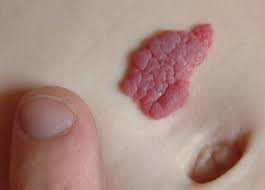Definisi
Hemangioma kapiler adalah tumor jinak (non-kanker) yang terbentuk akibat pertumbuhan abnormal dari pembuluh kapiler (pembuluh darah kecil). Hemangioma kapiler merupakan tipe hemangioma yang paling sering ditemukan, berbentuk seperti benjolan dengan warna merah terang.
Hemangioma kapiler biasanya tidak muncul saat lahir dan mulai terlihat pada 6 bulan pertama kehidupan. Pertumbuhannya cukup cepat pada masa bayi dan dapat hilang sendiri seiring bertambahnya usia anak. Hemangioma umumnya tumbuh dengan cepat sampai usia 12 bulan dan kemudian mulai mengecil pada usia 12 bulan sampai 5 tahun. Biasanya hemangioma akan hilang total pada pada usia 5 atau 6 tahun.
Hemangioma kapiler dapat timbul pada berbagai area di tubuh. Jika tumbuh di area mata, dapat terlihat pada kelopak mata, konjungtiva atau selaput bening mata, dan rongga mata.
Penyebab
Hemangioma kapiler merupakan hasil dari pertumbuhan berlebih sel-sel dinding pembuluh darah. Sel-sel tersebut terus membelah secara tidak normal dan membentuk jaringan baru yaitu tumor, yang terlihat seperti benjolan. Pertumbuhan tumor ini bersifat jinak. Namun, belum diketahui secara pasti apa yang membuat tumor terbentuk atau yang memicu kondisi tersebut.
Pada hemangioma kapiler mata, terdapat 2 fase pertumbuhan dari tumor hemangioma kapiler. Fase pertama yaitu fase pertumbuhan cepat (proliferasi) biasanya terjadi pada usia 8 - 18 bulan. Pada fase ini, terjadi peningkatan sel-sel yang terlibat sebagai stimulus pertumbuhan dari pembuluh darah. Setelah fase proliferasi berakhir, akan dimulai fase selanjutnya yaitu pengecilan ukuran tumor secara perlahan (involusi). Pada fase ini, jumlah sel-sel yang meningkat di fase pertama, akan kembali normal. Sekitar 50% kasus tumor akan mengecil pada usia 5 tahun, dan 75% kasus hemangioma kapiler akan mengecil pada usia 7 tahun.
Faktor Risiko
Faktor keturunan atau faktor genetik belum terbukti secara signifikan meningkatkan risiko terbentuknya hemangioma kapiler pada anak. Dalam beberapa penelitian, dilaporkan bahwa hemangioma kapiler jarang terjadi pada ras Afrika. Faktor kelahiran prematur dan berat badan lahir rendah dikaitkan dengan peningkatan risiko anak mengalami hemangioma kapiler setelah lahir.
Faktor risiko lainnya yang diduga berperan antara lain adalah jenis kelamin perempuan, dengan rasio kasus hemangioma kapiler pada anak perempuan dan laki-laki adalah 3:2 sampai 5:1. Selain itu, gangguan perkembangan yang terjadi saat dalam kandungan juga bisa meningkatkan risiko anak mengalami hemangioma kapiler.
Gejala
Hemangioma kapiler biasanya muncul setelah lahir, dalam 6 bulan pertama kehidupan (30% kasus ditemukan saat lahir, 50% kasus terjadi pada anak berusia 1 - 2 bulan, dan 90% kasus pada 6 bulan). Tumor jinak ini dapat muncul di kulit, lapisan bawah kulit, atau di area mata dan sekitarnya.
Gejala yang muncul bisa bervariasi pada setiap pasien. Umumnya, hemangioma kapiler tampak sebagai bercak menonjol atau benjolan berwarna merah terang, teraba tegang dan berbatas tegas. Benjolan merah ini dapat timbul pada berbagai tempat di tubuh. Benjolan akan memucat jika ditekan dan konsistensi benjolan mirip dengan spons saat diraba.
Pada area mata, hemangioma terlihat sebagai bintik merah yang tumbuh di daerah sekitar mata. Jika mengenai kelopak mata, anak akan mengalami kesulitan membuka kelopak mata secara bertahap. Pasien biasanya datang dengan benjolan pada alis atau kelopak mata. Jika meluas hingga ke belakang rongga mata, bola mata dapat menonjol dan mungkin terjadi gangguan penglihatan.
Ambliopia atau mata malas ditemukan pada 43-60% pasien dengan hemangioma kelopak mata. Anisometropia atau perbedaan ketajaman penglihatan pada kedua mata dapat ditemukan pada pemeriksaan sebagai akibat dari penekanan kornea oleh benjolan hemangioma. Juling juga dapat terjadi jika benjolan menekan bola mata dan memengaruhi kerja otot mata.
Meskipun hemangioma dapat hilang dengan sendirinya, umumnya akan menimbulkan perbedaan warna kulit yang menetap pada area benjolan yang sudah mengempis, walaupun tidak seterang seperti saat pertama kali muncul.
Diagnosis
Dokter mendiagnosis hemangioma kapiler melalui informasi yang didapatkan dari pemeriksaan gejala, riwayat kesehatan pasien, hasil pemeriksaan fisik, serta pemeriksaan penunjang. Pemeriksaan laboratorium yang dapat membantu diagnosis adalah pewarnaan imunohistokimia. Pada pemeriksaan tersebut, didapatkan positif faktor VIII. Faktor VIII adalah protein dalam tubuh yang berperan pada proses pembekuan darah.
Meskipun umumnya terlihat pada kulit, pemeriksaan USG harus dilakukan untuk mengetahui apakah benjolan meluas ke jaringan atau organ sekitar. Pemeriksaan radiologi juga sangat membantu dalam menegakkan diagnosis. Ultrasonografi (USG) akan menunjukkan benjolan dengan kontur tidak teratur. Pada benjolan di area sekitar mata, jika dicurigai adanya perluasan ke bagian dalam rongga mata, maka CT scan atau MRI dapat dilakukan.
Pada CT scan akan terlihat sebagai benjolan dengan aliran darah yang rendah tanpa gangguan jaringan sekitarnya dan tidak ada erosi tulang. Benjolan biasanya terlihat semakin jelas dengan pemberian zat kontras melalui pembuluh darah. Pada MRI, hemangioma kapiler tampak sebagai tumor padat berbatas tegas. Sedangkan pada pemeriksaan jaringan dengan mikroskop, ditemukan pertumbuhan berlebih pada sel dinding pembuluh darah.
Tata Laksana
Hemangioma kapiler dapat diobati dengan berbagai cara tergantung pada lokasi, tingkat keparahan, dan menyebabkan masalah penglihatan atau tidak. Hemangioma kapiler biasanya membutuhkan waktu beberapa tahun untuk mengecil. Kulit yang terkena dapat tetap terlihat merah, mungkin sedikit berkerut, atau bisa juga terlihat normal tergantung pada tahap penyembuhan hemangioma.
Obat-obatan
Propranolol, yaitu obat penyakit jantung golongan beta blocker, sekarang menjadi pengobatan lini pertama untuk hemangioma. Obat dalam bentuk oral atau diminum dan aman untuk digunakan. Pemantauan denyut jantung dan tekanan darah pada awal pengobatan terkadang diperlukan dan dapat dapat dilakukan pada rawat inap singkat di rumah sakit. Pada beberapa kasus, jika hemangioma mata tidak besar, obat tetes mata beta blocker juga dapat membantu.
Obat golongan steroid juga dapat digunakan untuk menghentikan perkembangan hemangioma. Tergantung pada ukuran dan lokasi hemangioma, steroid dapat diresepkan dalam bentuk tablet, disuntikkan langsung ke hemangioma, atau dioleskan ke permukaan kulit yang terdapat hemangioma. Obat steroid dapat memiliki efek samping yang tidak diinginkan.
Prosedur Lainnya
Terapi laser terkadang dapat digunakan pada hemangioma yang muncul di permukaan kulit untuk mencegah pertumbuhan, memperkecil ukuran dari benjolan, atau mencerahkan warnanya. Pembedahan tradisional untuk menghilangkan hemangioma di sekitar mata umumnya dilakukan pada hemangioma kecil yang berbatas tegas yang terletak di bawah permukaan kulit.
Komplikasi
Meskipun sebagian besar hemangioma kapiler dapat mengecil perlahan, beberapa benjolan akan mengalami pertumbuhan yang cepat dan dapat menekan jaringan atau organ sekitarnya. Pada hemangioma di area mata, dapat menyebabkan:
- Ambliopia atau mata malas
- Proptosis atau penonjolan bola mata
- Keratitis
- Penekanan saraf mata
- Luka dan pendarahan pada mata
Pengobatan dengan steroid perlu dipantau dengan ketat agar tidak terjadi efek samping seperti:
- Penurunan tekanan darah
- Detak jantung melambat
- Penurunan kadar gula darah
- Penyempitan saluran napas
- Gangguan tidur
- Diare
- Gangguan ion tubuh
Sementara itu, komplikasi dari prosedur pembedahan yang dapat terjadi adalah cedera pada jaringan di sekitarnya.
Pencegahan
Karena penyebab munculnya tumor belum diketahui dengan pasti, belum ada cara yang efektif untuk mencegah hemangioma kapiler. Selain itu, hemangioma kapiler umumnya dapat hilang sendirinya. Konsultasikan dengan dokter mengenai pilihan pengobatan yang sesuai untuk bayi Anda agar mencegah perburukan gejala dan komplikasi.
Kapan Harus ke Dokter?
Jika bayi Anda memiliki tanda gejala hemangioma kapiler seperti yang disebutkan di atas, periksakan ke dokter untuk dilakukan pemeriksaan dan terapi yang sesuai. Diagnosis dan pengobatan yang tepat dapat mencegah komplikasi, seperti penekanan organ atau jaringan sekitar.
Mau tahu informasi seputar penyakit lainnya? Cek di sini, ya!
- dr Hanifa Rahma
DeAngelis DD. (2019). Capillary hemangioma. Retrieved 22 April 2022, from https://emedicine.medscape.com/article/1218805-overview
Capillary hemangioma. (2020). Retrieved 22 April 2022, from https://aapos.org/glossary/capillary-hemangioma
Koka K, Patel BC. (2021). Capillary infantile hemangiomas. Retrieved 22 April 2022, from https://www.ncbi.nlm.nih.gov/books/NBK538249/
Osigian, CJ. (2021). Capillary hemangioma. Retrieved 22 April 2022, from https://eyewiki.aao.org/Capillary_Hemangioma#Demographics












